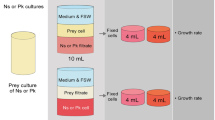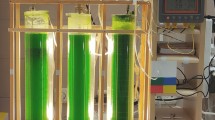Abstract
This work aims to: (1) correlate photochemical activity and productivity, (2) characterize the flow pattern of culture layers and (3) determine a range of biomass densities for high productivity of the freshwater microalga Chlorella spp., grown outdoors in thin-layer cascade units. Biomass density, irradiance inside culture, pigment content and productivity were measured in the microalgae cultures. Chlorophyll-fluorescence quenching was monitored in situ (using saturation-pulse method) to estimate photochemical activities. Photobiochemical activities and growth parameters were studied in cultures of biomass density between 1 and 47 g L−1. Fluorescence measurements showed that diluted cultures (1–2 g DW L−1) experienced significant photostress due to inhibition of electron transport in the PSII complex. The highest photochemical activities were achieved in cultures of 6.5–12.5 g DW L−1, which gave a maximum daylight productivity of up to 55 g dry biomass m−2 day−1. A midday depression of maximum PSII photochemical yield (F v/F m) of 20–30% compared with morning values in these cultures proved to be compatible with well-performing cultures. Lower or higher depression of F v/F m indicated low-light acclimated or photoinhibited cultures, respectively. A hydrodynamic model of the culture demonstrated highly turbulent flow allowing rapid light/dark cycles (with frequency of 0.5 s−1) which possibly match the turnover of the photosynthetic apparatus. These results are important from a biotechnological point of view for optimisation of growth of outdoor microalgae mass cultures under various climatic conditions.









Similar content being viewed by others
Abbreviations
- Chl:
-
Chlorophyll
- Car:
-
Carotenoids
- DW:
-
Dry weight
- F0, Fv, Fm:
-
Minimum, variable and maximum fluorescence in dark-adapted cultures
- F′, Fm′:
-
Actual and maximum level of fluorescence in light-adapted cultures
- Fv/Fm:
-
Maximum quantum yield of PSII
- ∆F/F m′:
-
Actual quantum yield of PSII
- L/D:
-
Light/dark
- NPQ:
-
Non-photochemical quenching (F m/F m′ − 1)
- N r :
-
Reynolds number
- PSII:
-
Photosystem II
- PQ:
-
Plastoquinone
- Q:
-
Quinone
References
Tredici M (2004) Mass production of microalgae: photobioreactors. In: Richmond A (ed) Handbook of microalgal mass cultures. Blackwell Science, Oxford, pp 178–214
Šetlík I, Šust V, Málek I (1970) Dual purpose open circulation units for large scale culture of algae in temperate zones. I. Basic design considerations and scheme of a pilot plant. Algol Stud 1:111–164
Kajan M, Tichý V, Simmer J (1994) Productivity of algae in different culture units. Algol Stud 73:111–117
Doucha J, Lívanský K (1995) Novel outdoor thin-layer high density microalgal culture system: productivity and operation parameters. Algol Stud 76:129–147
Torzillo G, Accolla P, Pinzani E, Masojídek J (1996) In situ monitoring of chlorophyll fluorescence to assess the synergistic effect of low temperature and high irradiance stresses in Spirulina grown in outdoor photobioreactors. J Appl Phycol 8:283–291
Torzillo G, Bernardini P, Masojídek J (1998) On-line monitoring of chlorophyll fluorescence to assess the extent of photoinhibition of photosynthesis induced by high oxygen concentration and low temperature and its effect on the productivity of outdoor cultures of Spirulina platensis (Cyanobacteria). J Phycol 34:504–510
Masojídek J, Torzillo G, Kopecký J, Koblížek M, Nidiaci L, Komenda J, Lukavská A, Sacchi A (2000) Changes in chlorophyll fluorescence quenching and pigment composition in the green alga Chlorococcum sp. grown under nitrogen deficiency and salinity stress. J Appl Phycol 12:417–426
Masojídek J, Vonshak A, Torzillo G (2009) Chlorophyll fluorescence applications in microalgal mass cultures. In: Suggett DJ, Prášil O, Borowitzka MA (eds) Chlorophyll a fluorescence in aquatic sciences: methods and applications (in press)
Schreiber U, Bilger W, Hormann H, Neubauer C (1998) Chlorophyll fluorescence as a diagnostic tool: basics and some aspects of practical relevance. In: Raghavendra AS (ed) Photosynthesis: a comprehensive treatise. Cambridge University Press, UK, pp 320–334
Schreiber U (2004) Pulse-amplitude-modulation (PAM) fluorometry and saturation pulse method: an overview. In: Papageorgiou GC, Govindjee (eds) Chlorophyll a fluorescence: a signature of photosynthesis. Advances in photosynthesis and respiration, vol 19. Springer, The Netherlands, pp 279–319
Strasser RJ, Tsimili-Michael M, Srivastava A (2004) Analysis of the chlorophyll a fluorescence transient. In: Papageorgiou GC, Govindjee (eds) Chlorophyll a fluorescence: a signature of photosynthesis. Advances in photosynthesis and respiration, vol 19. Springer, The Netherlands, pp 321–362
Schreiber U, Endo T, Mi H, Asada K (1995) Quenching analysis of chlorophyll fluorescence by the saturation pulse method: particular aspects relating to the study of eukaryotic algae and cyanobacteria. Plant Cell Physiol 36:873–882
Strasser RJ, Srivastava A, Govindjee (1995) Polyphasic chlorophyll a fluorescence transient in plants and cyanobacteria. Photochem Photobiol 61:33–42
Baker NR (2008) Chlorophyll fluorescence: a probe of photosynthesis in vivo. Ann Rev Plant Biol 59:89–113
Björkman O, Demmig B (1987) Photon yield of O2 evolution and chlorophyll fluorescence characteristics at 77 K among vascular plants of diverse origins. Planta 170:489–504
Genty B, Briantais JM, Baker NR (1989) The relationship between the quantum yield of photosynthetic electron transport and quenching of chlorophyll fluorescence. Biochim Biophys Acta 990:87–92
Doucha J, Lívanský K (2006) Productivity, CO2/O2 exchange and hydraulics in outdoor open high density microalgal (Chlorella sp.) photobioreactors operated in a Middle and Southern European Climate. J Appl Phycol 18:811–826
Douglas JF, Gasiorek JM, Swaffield JA (2005) Fluid mechanics, 5th edn. Prentice Hall, New Jersey, USA, p 958
Lichtenthaler HK, Wellburn AR (1983) Determination of total carotenoids and chlorophyll a and b of leaf extracts in different solvents. Biochem Soc Trans 603:591–592
Gilmore AM, Yamamoto HY (1991) Zeaxanthin formation and energy dependent fluorescence quenching in pea chloroplasts under artificially mediated linear and cyclic electron transport. Plant Physiol 96:635–643
Richmond A (2004) Biological principles of mass cultivation. In: Richmond A (ed) Handbook of microalgal mass cultures. Blackwell Science, Oxford, pp 125–177
Grobbelaar JU (1989) Turbulence in mass algal cultures and the role of light/dark fluctuations. J Appl Phycol 6:331–335
Janssen M, Janssen M, de Winter M, Tramper J, Mur LR, Snel J, Wijffels RH (2000) Efficiency of light utilization of Chlamydomonas reinhardtii under medium-duration light/dark cycles. J Biotech 78:123–137
Janssen M, Kuijpers TC, Veldhoen B, Ternbach MB, Tramper J, Mur LR, Wijffels RH (1999) Specific growth rate of Chlamydomonas reinhardtii and Chlorella sorokiniana under medium duration light/dark cycles: 13–87 s. J Biotech 70:323–333
Barbosa MJ, Janssen M, Ham N, Tramper J, Wijffels RH (2003) Microalgae cultivation in air-lift reactors: modeling biomass yield and growth rate as a function of mixing frequency. Biotech Bioeng 82:170–179
Myers J, Graham J (1958) On the mass culture of algae. II. Yield as a function of cell concentration under continuous sunlight irradiance. Plant Physiol 34:345–352
Torzillo G, Sacchi A, Materassi R, Richmond A (1991) Effect of temperature on yield and night biomass loss in Spirulina platensis grown outdoors in tubular photobioreactors. J Appl Phycol 3:103–109
Vonshak A, Torzillo G, Masojídek J, Boussiba S (2001) Sub-optimal morning temperature induces photoinhibition in dense outdoor cultures of the alga Monodus subterraneus (Eustigmatophyta). Plant Cell Envir 24:1113–1118
Rodolfi L, Chini-Zittelli G, Bassi N, Padovani G, Biondi N, Bovini G, Tredici MR (2009) Microalgae for oil: strain selection, induction of lipid synthesis and outdoor mass cultivation in a low-cost photobioreactor. Biotechnol Bioeng 102:100–112
Acknowledgments
The authors thank Mr. Radek Plch, Ms. Jana Hofhanzlová, Ms. Lada Samcová and Mr. Petr Novotný for technical assistance, Mr. Jan Červený for software set-up, Mr. Pavel Souček for preparation of diagrams, Prof. Josef Komenda for critical discussion, Dr. Steve Ridgill for language corrections, Dr. AnnaRita Leva for statistical analysis and three anonymous reviewers for their constructive remarks. Travel support to G.T. was funded from bilateral scientific agreement between the Italian CNR and the Czech Academy of Sciences. The Czech Science Foundation supported this work through projects 522/06/1090 and 521/09/0656. Partial funding was also provided by project MSM6007665808 of the Ministry of Education and by project AVOZ 50200510 of the Czech Academy of Sciences, and by Italian MIUR (Ministero dell’Istruzione, Università e Ricerca), FISR 2002, prot. N. 1756 828.07.2005, and by the Italian Space Agency (project MoMa contract number I/014/06/0).
Author information
Authors and Affiliations
Corresponding author
Rights and permissions
About this article
Cite this article
Masojídek, J., Kopecký, J., Giannelli, L. et al. Productivity correlated to photobiochemical performance of Chlorella mass cultures grown outdoors in thin-layer cascades. J Ind Microbiol Biotechnol 38, 307–317 (2011). https://doi.org/10.1007/s10295-010-0774-x
Received:
Accepted:
Published:
Issue Date:
DOI: https://doi.org/10.1007/s10295-010-0774-x




